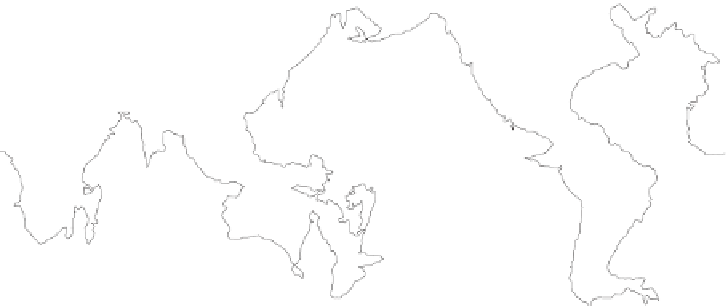Geoscience Reference
In-Depth Information
Mid-ocean
ridge basalts
(MORB)
Siberia
Ocean island
basalts (OIB)
Plateau
basalts
Orogenic
volcanism
Iceland
Siberia
Deccan
Haw
a
ii
Azores
Onto
n
g-Java
Caribb
e
an
Karoo
Galapagos
Par
a
na
Réunion
Society Is.
Kerguelen
Figure 11.7
The geographical distribution of different types of volcanism. To bring out the shallower parts of
the ocean (ridges and plateaus) the
−
3000 m depth contour is shown (drawn using GMT).
dry olivine is stiffer than wet olivine and melting leaves behind a fairly rigid residue. The
production of lava is associated with decompression of the mantle in plumes and beneath
oceanic ridges but also with dehydration of wet material (weathered sediments and basalts)
sinking in subduction zones. These three sites produce basalts, i.e. lavas rich in Mg, Ca,
and Fe and poor in Si. Other types of magma are associated with continental collision
zones: these are felsic magmas rich in Si and poor in Mg, whose characteristic product is
common granite. Continental margins are often associated with mixed magmatism, which
goes by the name of orogenic magmatism. Examples are the deadly eruptions of Mount
Pelée, Mount Pinatubo, or El Chichon. A common type of lava erupted by these volcanoes
is andesite.
The nature of the mantle, which produces different types of basalt, is an active area
of research. The greatest progress has been accomplished recently for the ocean island
basalts (OIB) that form chains of volcanoes associated with hot spots, and the mid-
ocean ridge basalts (MORB) that form the ocean floor. Production of MORB is connected
with decompression of the upper layers of mantle, forming the asthenosphere, which rise
beneath the mid-ocean ridges.
Mid-ocean ridge basalts are extremely depleted in highly incompatible elements such as
Ba, Th, K, and light rare-earths compared with what might be expected of the melting of
unprocessed mantle peridotite: the asthenospheric mantle had already lost a large propor-
tion of its most readily fusible elements before the present-day MORB formed. This can
be shown easily by comparing two trace elements with different degrees of compatibility,
e.g. two elements of the rare-earth family, ytterbium (Yb) and lanthanum (La). If
F
is the























































































































































































































































































































































































































































































































































































































































































































































































































































































































































































































































































































































































































































































































































































































































































































































































































































































































































































































































































































































































































































































































